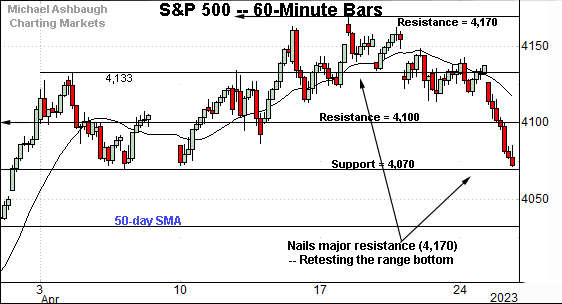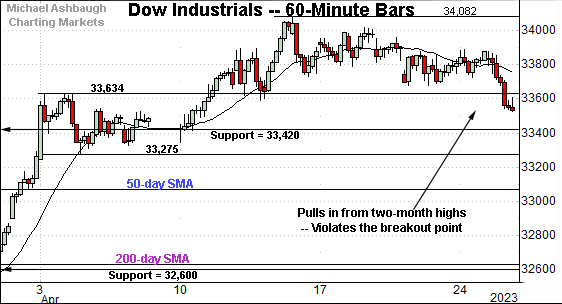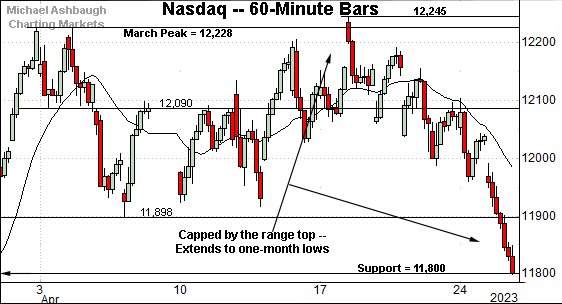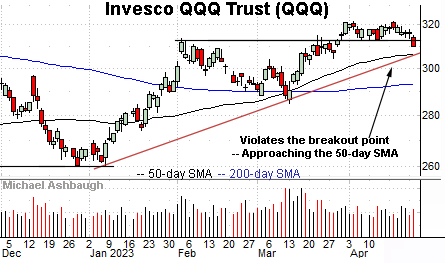Market bears resurface (sort of), S&P 500 balks at major resistance
Focus: Nasdaq extends downdraft from key resistance, QQQ challenges major support
Technically speaking, the bigger-picture backdrop has softened on the margin with the month of May — and the worst six months seasonally — set to start next week.
On a headline basis, the S&P 500 and Nasdaq Composite have balked at two key technical levels — S&P 4,170 and Nasdaq 12,270 — extending pullbacks from major resistance. The turn-of-the-month price action will likely add color.
Editor’s Note: As always, updates can be directly accessed at https://chartingmarkets.substack.com.
Before detailing the U.S. markets’ wider view, the S&P 500’s hourly chart highlights the past four weeks.
As illustrated, the S&P 500 has pulled in to the range bottom, an area matching the April low (4,070).
The prevailing downturn originates from major resistance (4,170), an area also detailed on the daily and weekly charts.
The April peak (4,169.5) matched resistance, and late-month selling pressure has surfaced.
Meanwhile, the Dow Jones Industrial Average has extended a less aggressive downturn.
Nonetheless, the pullback places it back under the breakout point (33,634) an area that pivots to resistance.
Delving deeper, the 33,420 area marks firmer support, also detailed on the daily chart.
Against this backdrop, the Nasdaq Composite has pulled in more aggressively.
The prevailing downturn punctuates a failed test of the range top, placing major support (11,800) back in play. (Also see the April 20 review.)
Widening the view to six months adds perspective.
On this wider view, the Nasdaq has balked at major resistance (12,270), an area defined by the Sept. peak (12,270) and Feb. peak (12,269).
The prevailing pullback places the 50-day moving average, currently 11,786, within view. The response to the 50-day — at the turn of the month — will likely add color.
Broadly speaking, an eventual violation of the 11,785-to-11,800 area would raise an intermediate-term caution flag. (Also see the hourly chart.)
Looking elsewhere, the Dow Jones Industrial Average has stalled near the 34,000 mark.
Still, the prevailing pullback has thus far ben orderly. Tactically, the 33,420 area is followed by the deeper 50-day moving average, currently 33,074. A sustained posture higher signals a bullish intermediate-term bias.
More broadly, the index is traversing a prolonged range hinged to the steep October-through-November rally. Constructive price action. (Also see the hourly chart.)
Meanwhile, the S&P 500 has failed a key technical test.
The specific area matches major resistance (4,170), a level extending back two years, as detailed on the weekly chart in the next section.
The April peak (4,169.5) matched resistance, and selling pressure has accelerated this week.
The bigger picture
As detailed above, the bigger-picture backdrop has softened on the margin with the month of May — and the worst six-month seasonal phase — set to start next week.
On a headline basis, the major benchmarks have balked at two significant, and increasingly familiar, technical levels:
S&P 500 resistance at 4,170. The April peak (4,169.5) matched resistance.
Nasdaq resistance at 12,270. The April peak (12,245) has registered nearby.
Morover, selling pressure accelerated this week to punctuate each benchmark’s failed test. Consider that Tuesday marked a nearly 7-to-1 down day on the NYSE. (Declining volume surpassed advancing volume by a nearly 7-to-1 margin.)
As always, in a textbook world, two 9-to-1 down days — across about a seven-session window — reliably signals a material trend shift. So the turn of the month price action will be worth tracking. To this point, the bigger-picture damage has been relatively limited.
Moving to the small-caps, the iShares Russell 2000 ETF (IWM) has reversed course.
The prevailing downturn punctuates a sluggish April rally attempt, capped by the 200-day moving average. Eventual downside follow-through — under the prevailing range — remains a prospect.
Tactically, the range bottom (170.30) remains an important floor. The pending retest should be a useful bull-bear gauge.
Similarly, the SPDR S&P MidCap 400 ETF (MDY) has pulled in from a formerly tight mid-April range.
In the process, the MDY has ventured back under its 200-day moving average, currently 450.96. Price action has been hinged to the 200-day for about seven weeks.
More broadly, recall the developing head-and-shoulders top defined by the December, February and April peaks. (Also see the Russell 2000’s backdrop.)
Returning to the S&P 500, this next chart is a weekly view spanning 30 months. Each bar on the chart represents one week.
As illustrated, the S&P has stalled at major resistance (4,170) detailed repeatedly. (See for instance, the May 3, 2022 review, and more recently, the March 15, 2023 review.)
The April peak (4,169.5) has matched resistance.
Conversely, recall the prevailing upturn originates from major support (3,810). The March low (3,809) registered nearby.
Narrowing to the S&P 500’s six-month view adds perspective.
Consider that loosely speaking, the range detailed on the weekly chart — spanning from 3,810 to 4,170 — has defined the 2023 price action. Just two closes have registered narrowly outside this range.
(Notably, the range precedes 2023. See the Dec. 20, 2022 review.)
Against this backdrop, the prevailing pullback from resistance has inflicted limited damage in the broad sweep. Nonetheless, Tuesday’s 7-to-1 down day marked acceleration, and is worth tracking for potential downside follow-through near the turn of the month.
Tactically, near-term support (4,070) is closely followed by the 50-day moving average, currently 4,033. A sustained posture atop the 50-day signals a bullish intermediate-term bias.
More broadly, the S&P 3,940-to-3,960 area remains a more important bull-bear fulcrum, matching two inflection points:
The 200-day moving average, currently 3,961.
The mid-point of the late-2022 range (3,942).
As always, it’s not just what the markets do, it’s how they do it. But generally speaking, the S&P 500’s bigger-picture bias remains bullish-leaning barring a violation of the S&P 3,950 area.
Concluding with a stray note, the Invesco QQQ Trust (QQQ) tracks the Nasdaq 100 Index offering a proxy for large-cap technology.
As illustrated, the shares have violated the breakout point (312.70), pulling in to one-month lows. The downturn punctuates a tight April range — a coiled spring — laying the groundwork for potentially more decisive follow-through.
Tactically, the 50-day moving average, currently 306.60, roughly matches trendline support. An eventual violation would raise an intermediate-term caution flag. Conversely, a swift reversal back atop the breakdown point (312.70) would place the shares on firmer technical ground.
Editor’s Note: The next review will be published Wednesday, May 3.














